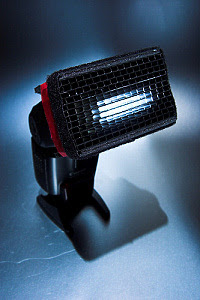Product Shots: Behind the Scenes
This journal entry is based round a product photo, and some overall shots which show the setup. There were two tricks to this shot which I thought were worth some mention. The first is how I got the gradient colour background from purple to silver, and the second is how I got smooth clean lighting on the screen, without any harsh highlights. So first of all, here's the shot.
The gradient background is actually pretty simple. I got some silver paper which reflects light quite a bit (you can see the reflection of the multimeter at the bottom). The top of the image reflects light in front of the multimeter, and the bottom reflects light above the multimeter. So therefore the colour you want at the bottom should be softly lit from above, and the colour you want the top should be lit from the front. For this reason, I just used the light I was lighting the multimeter with to light the top of the background. I put a softbox in above with a purple gel filter for the bottom part of the image, and the shape of the background paper makes the gradient fill work.
To smoothly light the screen, I needed a soft even source of light in front of the multimeter. To do this, I got two white sheets of foam board to the left and right of the camera angle. Two flashes fired up towards these boards, reflecting and creating the light source. I angled the boards back to drop the light off towards the top of the multimeter, making the screen a bit easier to read.
For a bit of added punch, I used a warming Daylight -> Tungsten conversion filter gel on the flash to the right of the camera, and you can see its given a warm colour to the highlight on the right of the multimeter, and also made the light on the front of the multimeter nice and warm.
So that's all there is to it...pretty simple. Here's some shots of the setup.
































